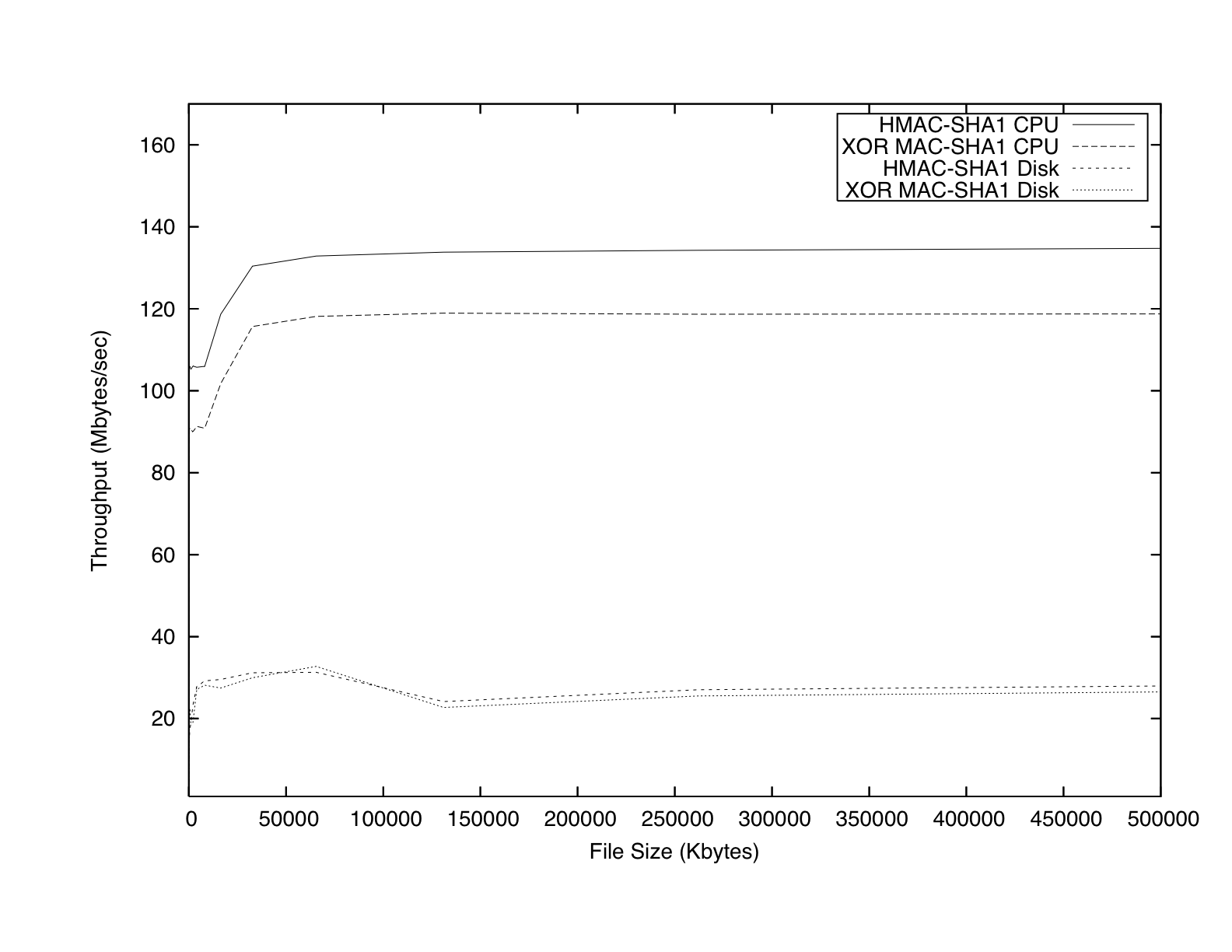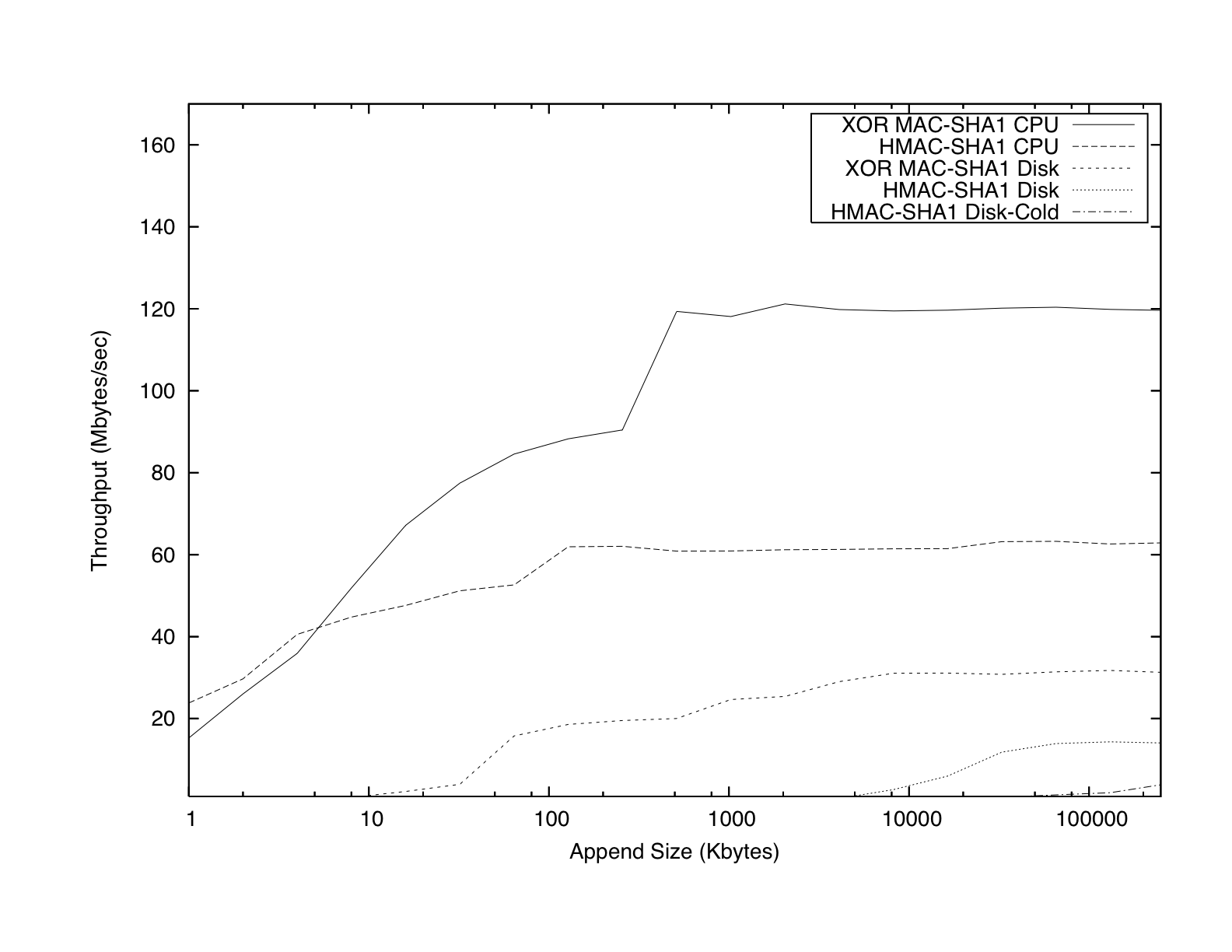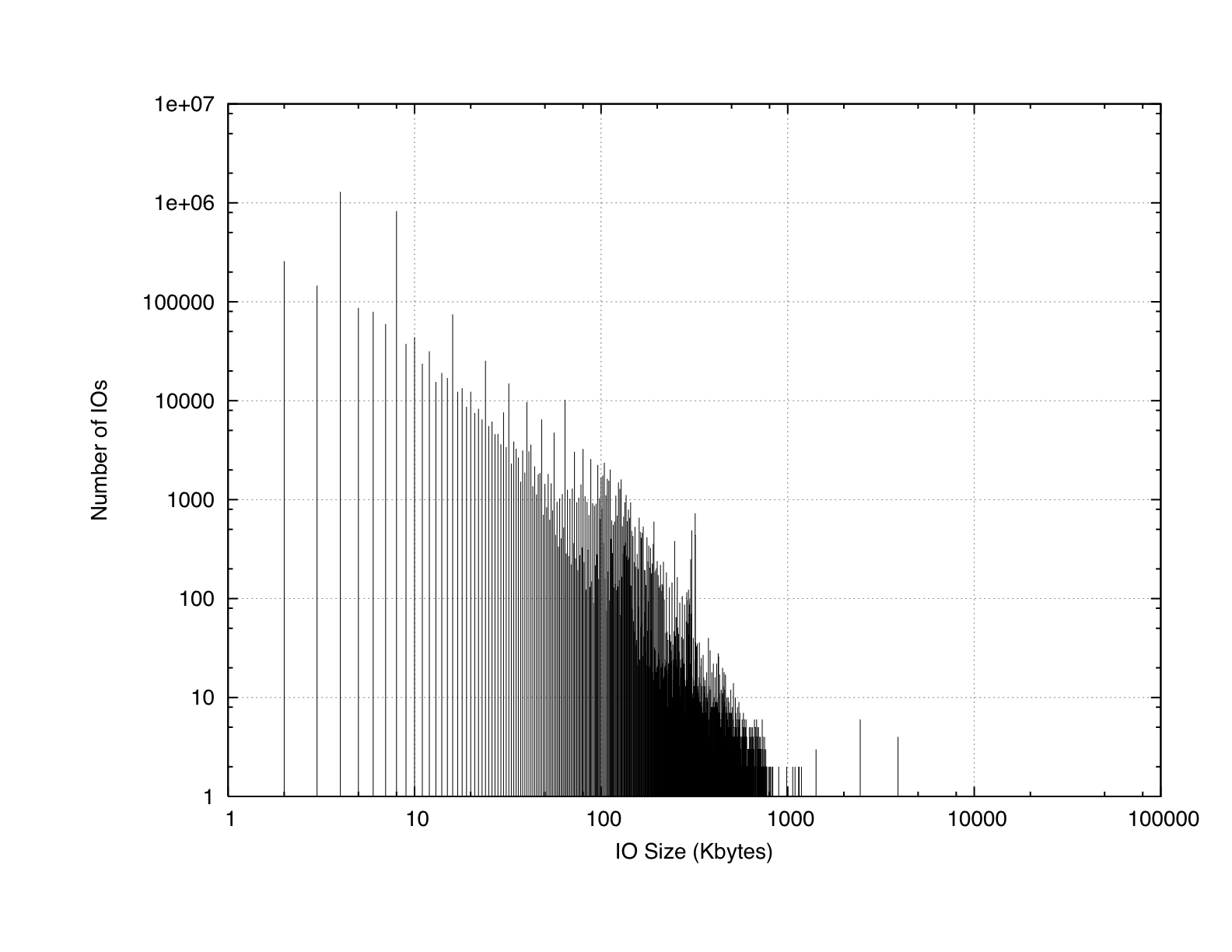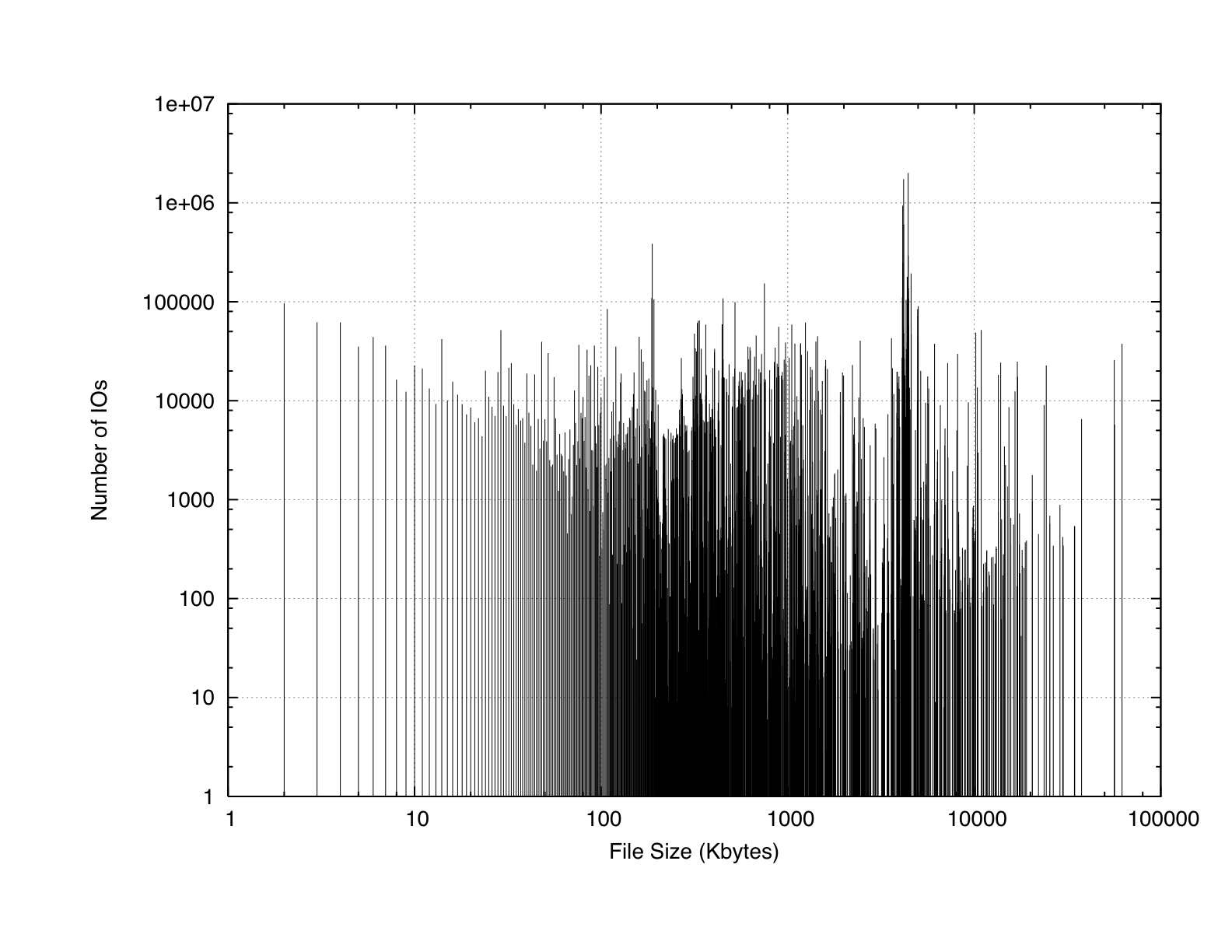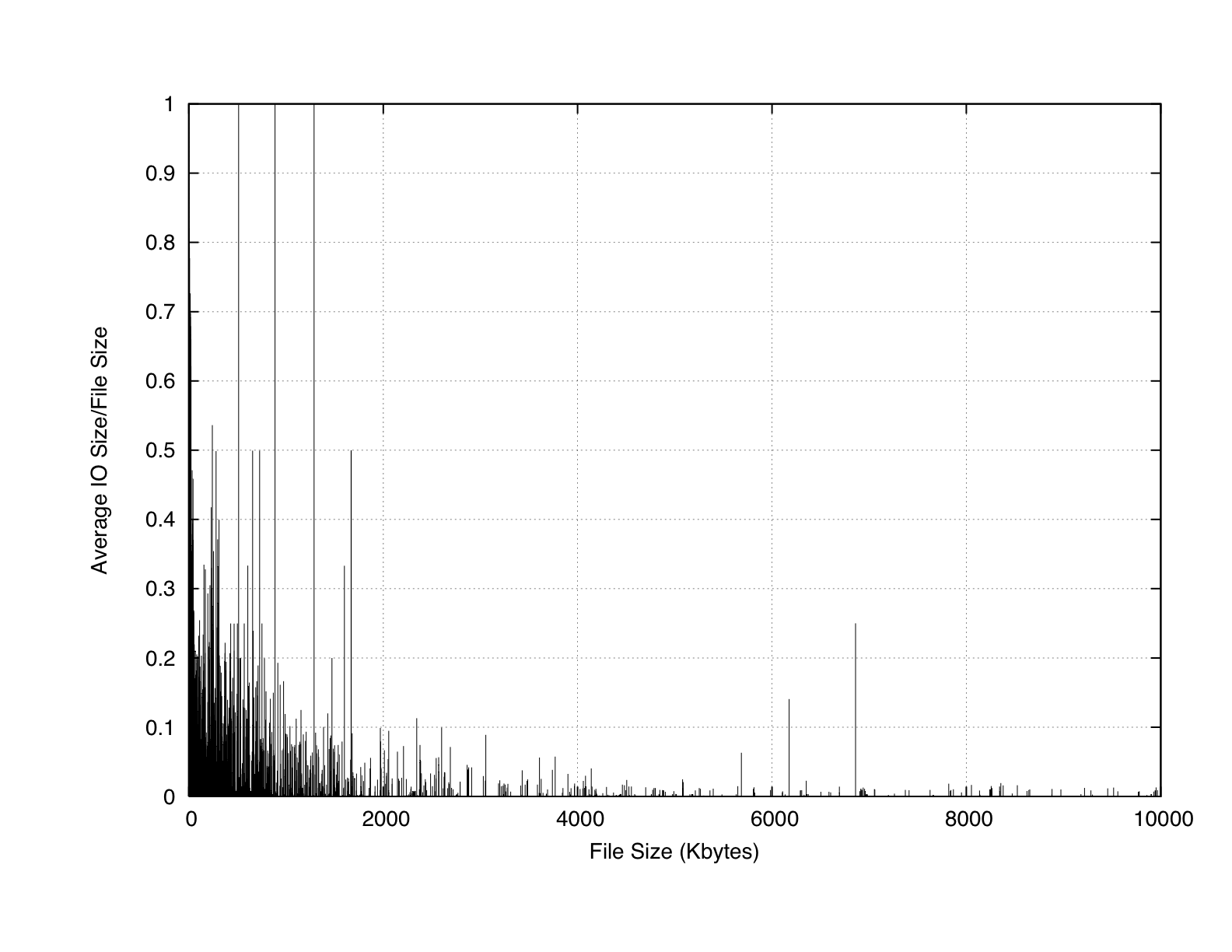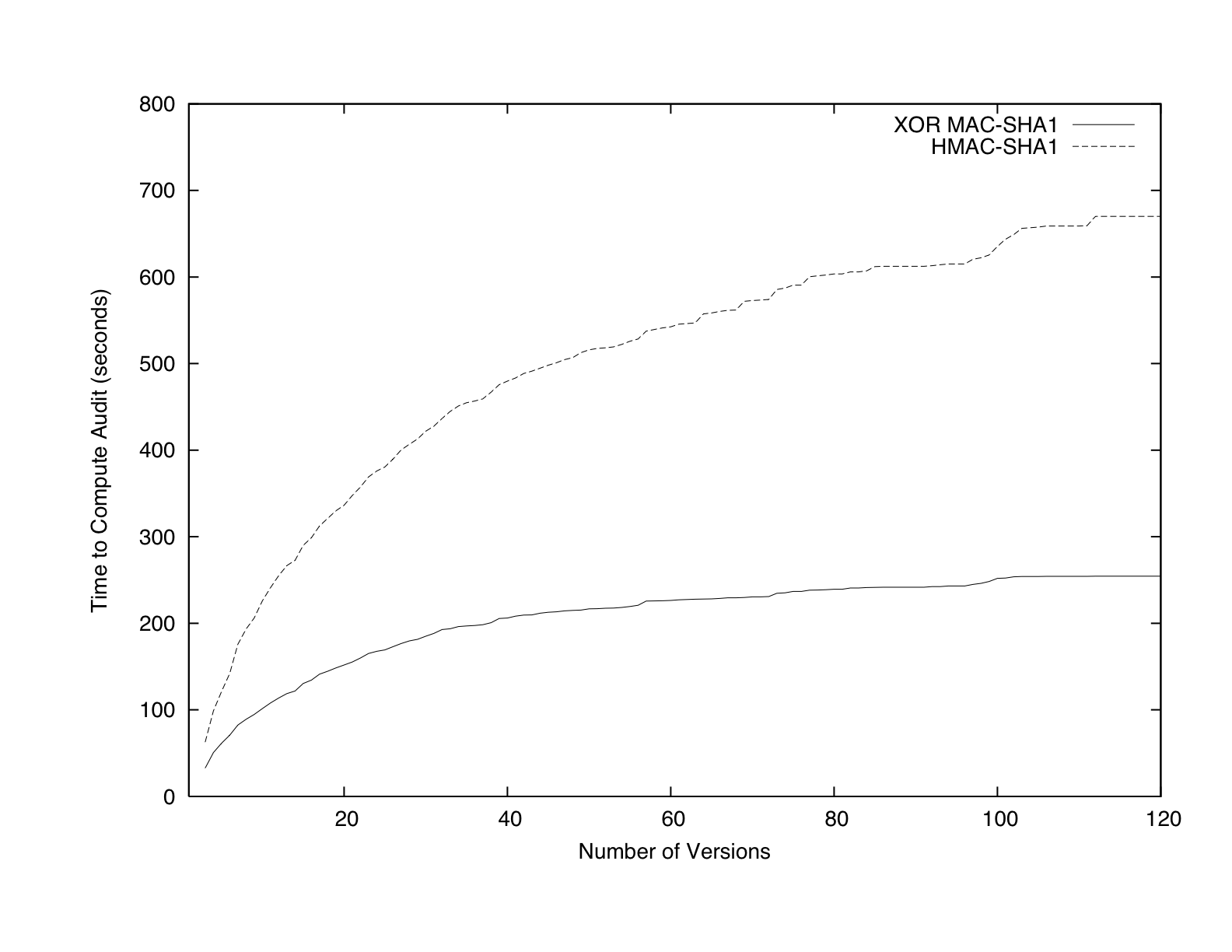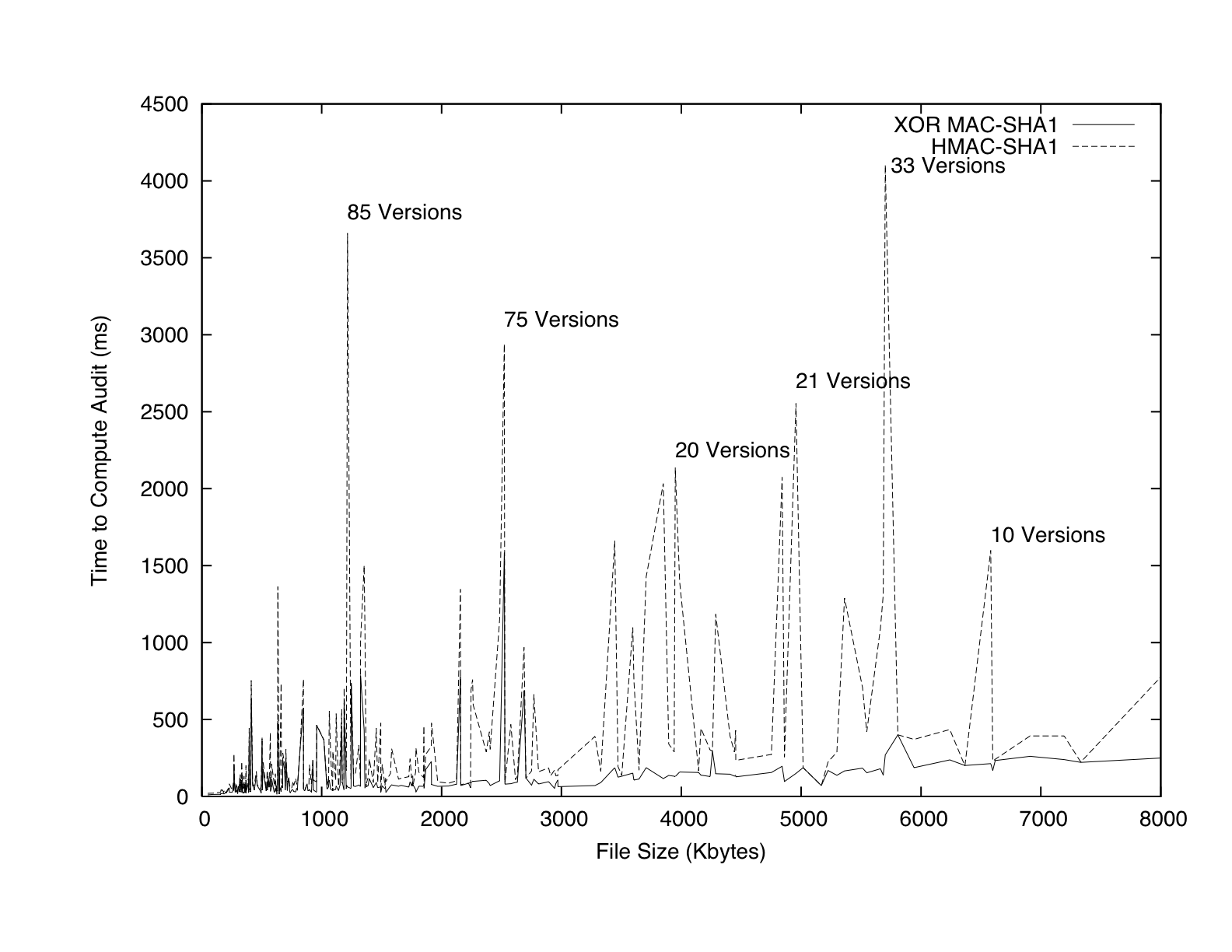|
||||||||||||||
XORing out the contributions of the old block and old random seed to make T and XORing in the contributions of the new block and new random seed to build Z'. File systems perform only block replacements. They do not insert or delete data, which would change the alignment of the blocks within a file. PMAC [6] improves upon XOR MAC in that it makes fewer calls to the underlying block cipher. XOR MAC expands data by concatenating an index to the message block. PMAC avoids this expansion by defining a sequence of distinct offsets that are XORed with each message block. Thus, it operates on less data, resulting in fewer calls to the underlying block cipher. Indeed, we initially proposed to use PMAC in our system [7]. However, when XOR MAC or PMAC are instantiated with keyed hash functions (rather than block ciphers), the performance benefits of PMAC are minimal for file systems. The reason is that HMAC-SHA1 accepts large inputs, permitting the use of a 4096 byte file system block. The incremental cost of a 64 bit expansion, representing a block index, is irrelevant when amortized over a 4096 byte block. At the same time, XOR MAC is simpler than PMAC and easier to implement. (On the other hand, PMAC is deterministic, requires no random inputs, and produces smaller output). In our system, we elect to implement XOR MAC.
4.2 XOR MAC for Audit Trails
We use the incremental property of XOR MAC to perform block-incremental
computation for copy-on-write file versions.
Each version
in which
This extends trivially to any number of changed blocks. The updated version authenticator adds the contribution of the changed blocks and removes the contribution of those blocks in the previous version. It also updates the contributions of the past version authenticator, normalized metadata, and random seed.
The computation of XOR MAC authenticators scales with
the amount of I/O, whereas the performance of a hash message authentication code
(HMAC) scales with the file size.
With XOR MAC, only new
data being written to a version will be authenticated. HMACs must
process the entire file, irrespective of the amount of I/O.
This is problematic as
studies of versioning file systems show that data change at a fine
granularity [31,38].
Our results (Section 6) confirm the same.
More importantly, the computation of the XOR MAC version authenticator
requires only those data blocks being
modified, which are already in cache, requiring little to no
additional disk I/O. Computing an HMAC may require additional
I/O. This is because
system caches are managed on a page basis, leaving
unmodified and unread portions of an individual file version on disk.
When computing an HMAC for a file,
all file data would need to be accessed.
As disk accesses are a factor of The benefits of incremental computation of MACs apply to both writing data and conducting audits. When versions of a file share much data in common, the differences between versions are small, allowing for efficient version verification. Incremental MACs allow an auditor to authenticate the next version by computing the authenticity of only the data blocks that have changed. When performing an audit, the authenticity of the entire version history may be determined by a series of small, incremental computations. HMACs do not share this advantage and must authenticate all data in all versions.
|
||||||||||||||||||||||||
![$\displaystyle H_K ( 00 \vert\vert r_{D_i}) \oplus \left[ \bigoplus_{j=1}^{n} H_K(01 \vert\vert\langle j \rangle \vert\vert name_j \vert\vert A_{v_{j}} ) \right]$](dmac.png) |
 |
This binds files and sub-directories to the authenticator of the parent directory. Directory version authenticators continue recursively to the file system root, protecting the entire file system image. The SFS-RO system [13] used a similar technique to fix the contents of a read-only file system without versioning. Our method differs in that it is incremental and accounts for updates.
For efficiency reasons, we bind versions to the directory's
authenticator lazily.
Figure 1 shows how directory D
binds
to files S, T, U.
This is done by including the authenticators
for specific versions
![]() that were current at
the time version
that were current at
the time version ![]() was created. However, subsequent file versions
(e.g.
was created. However, subsequent file versions
(e.g. ![]() ) may be created without updating
the directory version authenticator
) may be created without updating
the directory version authenticator ![]() .
The system updates the directory authenticator only when the
directory contents change; i.e., files are created, destroyed, or
renamed.
In this example, when deleting file
.
The system updates the directory authenticator only when the
directory contents change; i.e., files are created, destroyed, or
renamed.
In this example, when deleting file ![]() (Figure 1),
the authenticator is updated to the current versions.
Alternatively, were we to bind directory version authenticators
directly to the content of the most recent file version, they
would need to be updated every time that a file is written.
This includes all parent directories recursively to the file
system root - an obvious performance concern as it would
need to be done on every write.
(Figure 1),
the authenticator is updated to the current versions.
Alternatively, were we to bind directory version authenticators
directly to the content of the most recent file version, they
would need to be updated every time that a file is written.
This includes all parent directories recursively to the file
system root - an obvious performance concern as it would
need to be done on every write.
Binding a directory authenticator to a file version binds it to all subsequent versions of that file, by hash chaining of the file versions. This is limited to the portion of the file's version chain within the scope of the directory. A rename moves a file from one directory's scope to another. Ext3cow employs timestamps for version numbers, which can be used to identify the valid file versions within each directory version.
Updating directory authenticators creates a time-space trade-off similar to that of publication frequency (see Section 4). When auditing a directory at a given point in time, the auditor must access the directory at the time when its was created and then follow the children files' hash chains forward to the specified point in time. Updating directory authenticators more frequently may be desirable to speed the audit process.
5 File System Implementation
We have implemented digital audit trails using XOR MAC in ext3cow [31], an open-source, block-versioning file system designed to meet the requirements of electronic records legislation. Ext3cow supports file system snapshot, per-file versioning, and a time-oriented interface. Versions of a file are implemented by chaining inodes together in which each inode represents a version. The file system traverses the inode chain to generate a point-in-time view of a file. Ext3cow provides the features needed for an implementation of audit trails: it supports continuous versioning, creating a new version on every write, and maintains old and new versions of data and metadata concurrently for the incremental computation of version authenticators. We store version authenticators for a file in its inode. We have already retrofitted the metadata structures of ext3cow to support versioning and secure deletion (based on authenticated encryption [32]). Version authenticators are a straightforward extension to ext3cow's already augmented metadata, requiring only a few bytes per inode.
5.1 Metadata for Authentication
Metadata in ext3cow have been improved to support incremental versioning authenticators for electronic audit trails. To accomplish this, ext3cow ``steals'' a single data block pointer from the inode, replacing it with an authentication block pointer, i.e. a pointer to disk block holding authentication information. Figure 2 illustrates the metadata architecture. The number of direct blocks has been reduced by one, from twelve to eleven, for storing an authenticator block (i_data[11]). Block stealing for authenticators reduces the effective file size by only one file system block, typically 4K.
Each authenticator block stores five fields: the
current version authenticator ( ),
the authenticator for the previous version (
),
the authenticator for the previous version (
 ), the
one-way hash of the authenticator for the previous version
(
), the
one-way hash of the authenticator for the previous version
(
![]() ), the authenticator for the penult-previous
version (
), the authenticator for the penult-previous
version (
![]() ),
and the the one-way hash of the authenticator for the penult-previous version
(
),
and the the one-way hash of the authenticator for the penult-previous version
(
![]() ). Each authenticator computation requires
access to the previous and penult-previous authenticators and their hashes.
By storing authenticators and hashes for previous versions together,
the system avoids two read I/Os: one
for each previous version authenticator and hash computations.
When a new version is generated and a new inode is created, the
authenticator block is copy-on-written and ``bumps'' each entry; i.e.,
copying the once current authenticator (
). Each authenticator computation requires
access to the previous and penult-previous authenticators and their hashes.
By storing authenticators and hashes for previous versions together,
the system avoids two read I/Os: one
for each previous version authenticator and hash computations.
When a new version is generated and a new inode is created, the
authenticator block is copy-on-written and ``bumps'' each entry; i.e.,
copying the once current authenticator ( ) to the previous
authenticator (
) to the previous
authenticator (
 ), and the previous authenticator
(
), and the previous authenticator
(
 ) and hash (
) and hash (
![]() ) to
the penult-previous authenticator (
) to
the penult-previous authenticator (
![]() ) and hash (
) and hash (
![]() ).
The once current authenticator (
).
The once current authenticator ( ) is zeroed, and is calculated
on an as-needed basis.
) is zeroed, and is calculated
on an as-needed basis.
In almost all cases, authenticator blocks do not increase the number of disk seeks performed by the system. The block allocator in ext3cow makes efforts to collocate data, metadata, and authenticator blocks in a single disk drive track, maintaining contiguity. Authenticator blocks are very likely to be read out of the disk's track cache. The same disk movement that reads inode or data blocks populates the track cache.
5.2 Key Management
Key management in ext3cow uses lockboxes [17] to store a per-file authentication key. The file owner's private key unlocks the lockbox and provides access to the authentication key. Lockboxes were developed as part of the authenticated encryption and secure deletion features of ext3cow [32].
6 Experimental Results
We measure the impact of authentication on versioning file systems and compare the performance characteristics of HMAC and XOR MAC in the ext3cow versioning file system. We begin by comparing the CPU and disk throughput performance of HMAC and XOR MAC by using two micro-benchmarks: one designed to contrast the maximum throughput capabilities of each algorithm and one designed to highlight the benefits of the incremental properties of XOR MAC. We then use a traced file system workload to illustrate the aggregate performance benefits of incremental authentication in a versioning file system. Lastly, we use file system traces to characterize some of the overheads of generating authenticators for the auditing environment. Both authentication functions, XOR MAC and HMAC, were implemented in the ext3cow file system using the standard HMAC-SHA1 keyed-hash function provided by the Linux kernel cryptographic API [25]. For brevity, XOR MAC implemented with HMAC-SHA1 is further referred to as XOR MAC-SHA1. All experiments were performed on a Pentium 4, 2.8GHz machine with 1 gigabyte of RAM. Trace experiments were run on a 80 gigabyte ext3cow partition of a Seagate Barracuda ST380011A disk drive.
6.1 Micro-benchmarks
To quantify the efficiency of XOR MAC, we conducted
two micro-benchmark experiments: create and append.
The create test measures the throughput
of creating and authenticating files
of size ![]() bytes, where
bytes, where
![]() (1 byte to 1 gigabyte files).
The test measures both CPU throughput, i.e. the time to calculate
a MAC, and disk throughput, i.e. the time to calculate a MAC and write
the file to disk. Files are created and written in their entirety.
Thus, there are no benefits from incremental authentication.
The append experiment measures the CPU and disk
throughput of appending
(1 byte to 1 gigabyte files).
The test measures both CPU throughput, i.e. the time to calculate
a MAC, and disk throughput, i.e. the time to calculate a MAC and write
the file to disk. Files are created and written in their entirety.
Thus, there are no benefits from incremental authentication.
The append experiment measures the CPU and disk
throughput of appending ![]() bytes to the same file and calculating a MAC,
where
bytes to the same file and calculating a MAC,
where
![]() (1 byte to 500 megabytes).
For XOR MAC, an append requires only a MAC of a new random
value, a MAC of each new data block and an XOR
of the results with the file's authenticator. HMAC does not have this
incremental property and must MAC the entire file data in order to generate
the correct authenticator, requiring additional read I/O.
We measure both warm and cold cache configurations. In a warm cache,
previous appends are still in memory and the read occurs at memory speed.
In practice, a system does not always find
all data in cache. Therefore, the experiment was also run with a cold cache;
before each append measurement, the cache was flushed.
(1 byte to 500 megabytes).
For XOR MAC, an append requires only a MAC of a new random
value, a MAC of each new data block and an XOR
of the results with the file's authenticator. HMAC does not have this
incremental property and must MAC the entire file data in order to generate
the correct authenticator, requiring additional read I/O.
We measure both warm and cold cache configurations. In a warm cache,
previous appends are still in memory and the read occurs at memory speed.
In practice, a system does not always find
all data in cache. Therefore, the experiment was also run with a cold cache;
before each append measurement, the cache was flushed.
Figure 3(a) presents the results of the
create micro-benchmark. Traditional HMAC-SHA1 has higher CPU
throughput than XOR MAC-SHA1, saturating the CPU at 134.8 MB/s. The
XOR MAC achieves 118.7 MB/s at saturation.
This is expected as XOR MAC-SHA1 performs two calls
to SHA1 for each block (see Equation 3), compared to HMAC-SHA1 that
only calls SHA1 twice for each file, resulting in additional computation time.
Additionally, SHA1 appends the length
of the message that it's hashing to the end of the message, padding
up to 512-bit boundaries. Therefore, XOR MAC-SHA1 hashes more data,
up to  *512 bits more for
*512 bits more for  blocks.
blocks.
Despite XOR MAC's computational handicap, disk throughput measurements show little performance disparity. HMAC-SHA1 achieves a maximum of 28.1 MB/s and XOR MAC-SHA1 a maximum of 26.6 MB/s. This illustrates that calculating new authenticators for a file system is I/O-bound, making XOR MAC-SHA1's ultimate performance comparable to that of HMAC-SHA1.
The results of the append micro-benchmark make a compelling performance argument for incremental MAC computation. Figure 3(b) shows these results - note the log scale. We observe XOR MAC-SHA1 outperforms HMAC-SHA1 in both CPU and disk throughput measurements. XOR MAC-SHA1 bests HMAC-SHA1 CPU throughput, saturating at 120.3 MB/s, compared to HMAC-SHA1 at 62.8 MB/s. Looking at disk throughput, XOR MAC-SHA1 also outperforms the best-case of an HMAC calculation, warm-cache HMAC-SHA1, achieving a maximum 31.7 MB/s, compared to warm-cache HMAC-SHA1 at 20.9 MB/s and cold-cache HMAC-SHA1 at 9.7 MB/s. These performance gains arise from the incremental nature of XOR MACs. In addition to the extra computation to generate the MAC, an ancillary read I/O is required to bring the old data into the MAC buffer. While the append benchmark is contrived, it is a common I/O pattern. Many versioning file systems implement versioning with a copy-on-write policy. Therefore, all I/O that is not a full overwrite is, by definition, incremental and benefits from the incremental qualities of XOR MAC.
6.2 Aggregate Performance
We take a broader view of performance by quantifying the aggregate benefits of XOR MAC on a versioning file system. To accomplish this, we replayed four months of system call traces [35] on an 80 gigabyte ext3cow partition, resulting in 4.2 gigabytes of data in 81,674 files. Despite their age, these 1996 traces are the most suitable for these measurements. They include information that allow multiple open/close sessions on the same file to be correlated - necessary information to identify versioning. More recent traces [11,19,36,38] do not include adequate information to correlate open/close sessions, are taken at too low a level in the IO system to be useful, or would introduce new ambiguities, such as the effects of a network file system, into the aggregate measurements. Our experiments compare trace-driven throughput performance as well as the total computation costs for performing a digital audit using the XOR MAC and HMAC algorithms. We analyze aggregate results of run-time and audit performance and examine how the incremental computation of MACs benefits copy-on-write versioning.
6.2.1 Write Performance
The incremental computation of XOR MAC minimally degrades on-line system performance when compared with a system that does not generate audit trails (No Authentication). In contrast, HMAC audit trails reduce throughput by more than an order of magnitude (Table 1). We measure the average throughput of the system while replaying four months of system call traces. The traces were played as fast as possible in an effort to saturate the I/O system. The experiment was performed on ext3cow using no authentication, HMAC-SHA1 authentication, and XOR MAC-SHA1 authentication. XOR MAC-SHA1 achieves a 93.9% improvement in run-time performance over HMAC-SHA1: 1.77 MB/s versus 0.11 MB/s. HMAC-SHA1's degradation results from the additional read I/O and computation time it must perform on every write. XOR MAC-SHA1 incurs minimal performance penalties owing to its ability to compute authenticators using in-cache data. XOR MAC-SHA1 achieves 89% of the throughput of a system with no authentication.
To better understand the run-time performance differences between XOR MAC and HMAC, we characterize the number and size of writes and how they are written to various files in the system. By looking at each write request as a function of its destination file size, we can see why incremental computation of MACs is beneficial to a file system. Our observations confirm three things: (1) Most write requests are small, (2) write requests are evenly distributed among all file sizes, and (3) the size of write requests are usually a tiny fraction of the file size. Figure 4(a) presents statistics on the number and size of write I/Os, whereas Figure 4(b) shows number of write I/Os performed by file size. Both plots are log-log. We observe that of the 16,601,128 write I/Os traced over four months, 99.8% of the I/Os are less than 100K, 96.8% are less than 10K, and 72.4% are less than 1K in size. This shows that a substantial number of I/Os are small. We also observe that files of all sizes receive many writes. Files as large as 100 megabytes receive as many as 37,000 writes over the course of four months. Some files, around 5MB in size, receive nearly two million I/Os. These graphs show that I/O sizes are, in general, small and that files of all sizes receive many I/Os.
The relationship between I/O size and file size reveals the necessity of incremental MAC computation. Figure 4(c) presents the average write I/O size as a ratio of the file size over file sizes. This plot shows that there are few files that receive large writes or entire overwrites in a single I/O. In particular, files larger than 2MB receive writes that are a very small percentage of their file size. The largest files receive as little as 0.025% of their file size in writes and nearly all files receive less than 25% of their file size in write I/Os. It is this disproportionate I/O pattern that benefits the incremental properties of XOR MAC. When most I/Os received by large files are small, a traditional HMAC suffers in face of additional computation time and supplementary I/Os. The performance of XOR MAC, however, is immune to file size and is a function of write size alone.
6.2.2 Audit Performance
|
To generate aggregate statistics for auditing, we aged the file system by replaying four months of traced system calls, taking snapshots daily. We then performed two audits of the file system, one using HMAC-SHA1 and one using XOR MAC-SHA1. Our audit calculated authenticators for every version of every file. Table 2 presents the aggregate results for performing an audit using XOR MAC-SHA1 and HMAC-SHA1. The table shows the result for all files and the result for those files with two or more versions. Auditing the entire 4.2 gigabytes of file system data using standard HMAC-SHA1 techniques took 11,209 seconds, or 3.11 hours. Using XOR MAC-SHA1, the audit took 10,593 seconds, or 2.94 hours; a savings of 5% (10 minutes).
Most files in the trace (88%) contain a single version, typical of user file systems. These files dominate audit performance and account for the similarity of HMAC and XOR MAC results. However, we are interested in file systems that contain medical, financial, and government records and, thus, will be populated with versioned data. To look at auditing performance in the presence of versions, we filter out files with only one version. On files with two or more versions, XOR MAC-SHA1 achieves a 62% performance benefit over HMAC-SHA1, 670 versus 254 seconds. A CDF of the time to audit files by number of versions is presented in Figure 5(a). XOR MAC-SHA1 achieves a 37% to 62% benefit in computation time over HMAC-SHA1 for files with 2 to 112 versions. This demonstrates the power of incremental MACs when verifying long version chains. The longer the version chain and the more data in common, the better XOR MAC performs.
Looking at audit performance by file size shows that the benefit is derived from long version chains. Figure 5(b) presents a break down of the aggregate audit results by file size. There exists no point at which XOR MAC-SHA1 performs worse than HMAC-SHA1, only points where they are the same or better. Performance is the same for files that have a single version and for files that do not share data among versions. As the number of versions increase and much data are shared between versions, large discrepancies in performance arise. Some examples of files with many versions that share data are annotated. XOR MAC shows little performance variance with the number of versions.
6.3 Requirements for Auditing
As part of our audit model, authenticators are transfered to and stored at a third party. We explore the storage and bandwidth resources that are required for version authentication. Four months of file system traces were replayed over different snapshot intervals. At a snapshot, authentication data are transfered to the third party, committing the file system to that version history. Measurements were taken at day, hour, and minute snapshot intervals. During each interval, the number of file modifications and number of authenticators generated were captured.
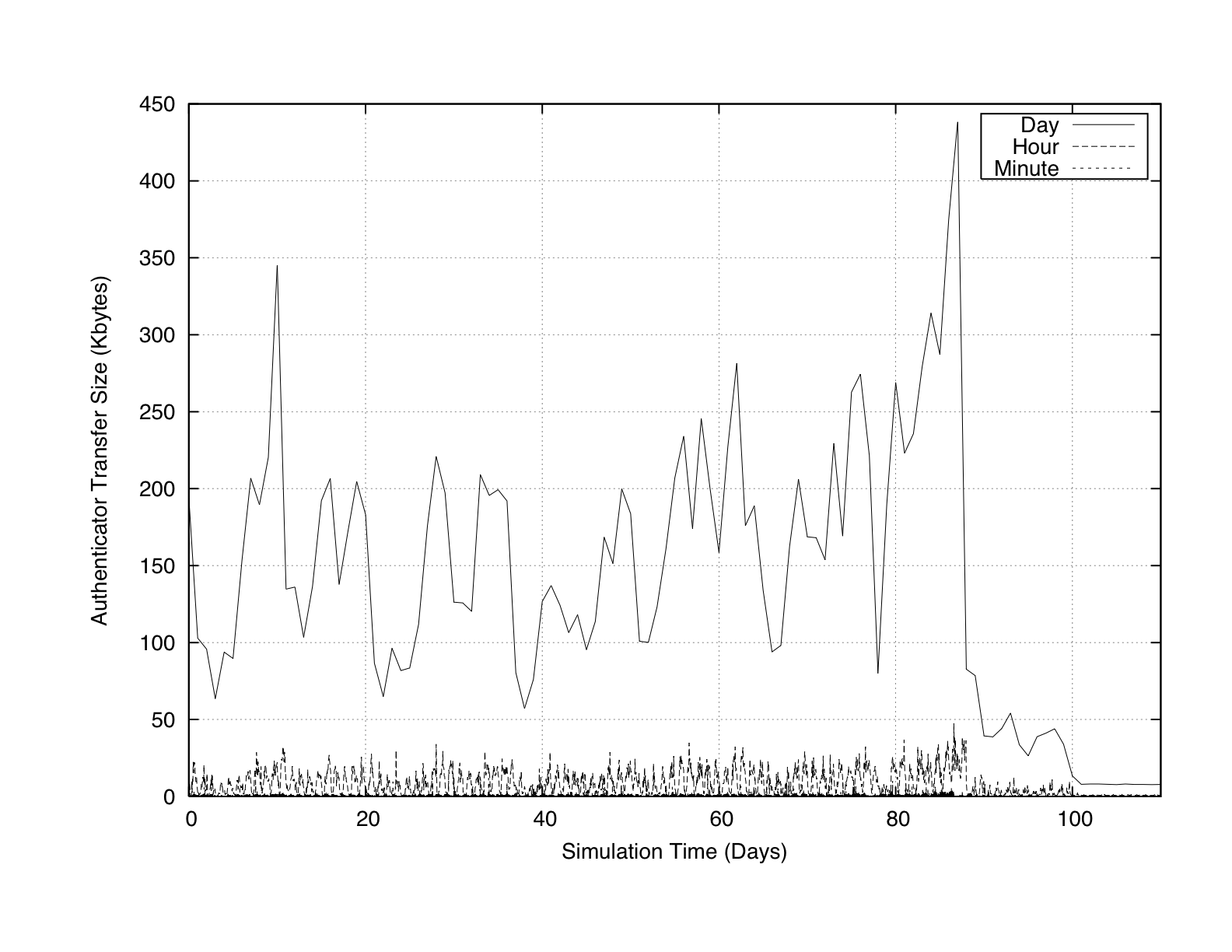
|
Figure 6 presents the size of authentication data generated over the simulation time for the three snapshot intervals. Naturally, the longer the snapshot interval, the larger the number of authenticators generated. However, authentication data are relatively small; even on a daily snapshot interval, the largest transfer is 450K, representing about 22,000 modified files. Authenticators generated by more frequent snapshot (hourly or per-minute) never exceed 50KB per transfer. Over the course of four months, a total of 15.7MB of authentication data are generated on a daily basis from 801,473 modified files, 22.7MB on a hourly basis from 1,161,105 modified files, and 45.4MB on a per-minute basis from 2,324,285 modified files. The size of authenticator transfer is invariant of individual file size or total file system size; it is directly proportional to the number of file modifications made in a snapshot interval. Therefore, the curves in Figure 6 are identical to a figure graphing the number of files modified over the same snapshot intervals.
7 Future Work
Conducting digital audits with version authenticators leaves work to be explored. We are investigating authentication and auditing models that do not rely on trusted third parties. We also discuss an entirely different model for authentication based on approximate MACs, which can tolerate partial data loss.
7.1 Alternative Authentication Models
Having a third party time-stamp and store a file system's authenticators may place undue burden, in terms of storage capacity and management, on the third party. Fortunately, it is only one possible model for a digital auditing system. We are currently exploring two other possible architectures for managing authentication data; a storage-less third party and cooperative authentication. In a storage-less third party model a file system would generate authenticators and transmit them to a third party. Instead of storing them, the third party would MAC the authenticators and return them to the file system. The file system stores both the original authenticators and those authenticated by the third party. In this way, the third party stores nothing but signing keys, placing the burden of storing authenticators on the file system. When the file system is audited, the auditor requests the signing keys from the third party and performs two authentication steps: first, checking the legitimacy of the stored authenticators and then checking the authenticity of the data themselves.
This design has limitations. The scheme doubles the amount of authentication data transfered. Additionally, because the third party keeps no record of any file, an attacker may delete an entire file system without detection or maintain multiple file systems, choosing which file system to present at audit time. Portions of the file system may not be deleted or modified, because the authenticators for version chains and directory hierarchies bind all data to the file system root authenticator.
A further variant groups peers of file systems
together into a cooperative ring, each storing their authentication data
on an adjoining file system. A file system would store the previous
system's authenticator in a log file, which is subsequently treated as
data, resulting in the authenticators being
authenticated themselves. This authenticator for the log file is
stored on an adjoining system, creating a ring of authentication.
This design relieves the burden on
a single third party from managing all authentication data and removes
the single point of failure for the system.
This architecture also increases the complexity of tampering by a factor of
 , the number of links of in the chain.
Because an adjoining file system's
authenticators are kept in a single log file, only one authenticator
is generated for that entire file system, preventing a glut
of authentication data.
, the number of links of in the chain.
Because an adjoining file system's
authenticators are kept in a single log file, only one authenticator
is generated for that entire file system, preventing a glut
of authentication data.
7.2 Availability and Security
A verifiable file system may benefit from accessing only a portion of the
data to establish authenticity.
Storage may be distributed across unreliable sites
[9,18],
such that accessing it in it's entirety is difficult or impossible.
Also, if data from any portion of the file system are
corrupted irreparably, the file system may still be authenticated,
whereas with standard authentication, altering a single bit of the
input data leads to a verification failure.
To audit incomplete data, we propose the use approximately-secure and approximately-correct MAC (AMAC) introduced by Di Crescenzo et al. [8]. The system verifies authenticity while tolerating a small amount of modification, loss, or corruption of the original data.
We propose to make the AMAC construction incremental to adapt it to file systems; in addition, we plan to use XOR MAC as a building block in the AMAC construction [8], to allow for incremental update. The atom for the computation is a file system block, rather than a bit. The approximate security and correctness then refer to the number of corrupted or missing blocks, rather than bits. The exact level of tolerance may be tuned.
The chief benefit of using the AMAC construction over regular MAC constructions lies in verification. Serial and parallel MACs require the entire message as input to verify authenticity. Using AMAC, a portion of the original message can be ignored. This allows a weaker statement of authenticity to be constructed even when some data are unavailable. The drawback of AMAC lies in the reduction of authenticity. With AMAC, some data may be acceptably modified in the original source.
8 Conclusions
We have introduced a model for digital audits of versioning file systems that supports compliance with federally mandated data retention guidelines. In this model, a file system commits to a version history by transmitting audit metadata to a third party. This prevents the owner of the file system (or a malicious party) from modifying past data without detection. Our techniques for the generation of audit metadata use incremental authentication methods that are efficient when data modifications are fine grained, as in versioning file systems. Experimental results show that incremental authentication can perform up to 94% faster than traditional serial authentication algorithms. We have implemented incremental authentication in ext3cow, an open-source versioning file system, available at: www.ext3cow.com.
9 Acknowledgments
This work was supported by the National Science Foundation (awards CCF-0238305 and IIS-0456027), by the Department of Energy, Office of Science (award DE-FG02-02ER25524), and by the IBM Corporation. We thank Giovanni Di Crescenzo for discussions on the AMAC construction.
Bibliography
- 1
-
ADAMS, C., CAIN, P., PINKAS, D., AND ZUCCHERATO, R.
IETF RFC 3161 Time-Stamp Protocol (TSP).
IETF Network Working Group, 2001. - 2
-
AMERICAN BANKERS ASSOCIATION.
American national standard for financial institution message authentication (wholesale).
ANSI X9.9, 1986. - 3
-
BELLARE, M., CANETTI, R., AND KRAWCZYK, H.
Keying hash functions for message authentication.
In Advances in Cryptology - Crypto'96 Proceedings (1996), vol. 1109, Springer-Verlag, pp. 1-19.
Lecture Notes in Computer Science. - 4
-
BELLARE, M., GOLDREICH, O., AND GOLDWASSER, S.
Incremental cryptography and application to virus protection.
In Proceedings of the ACM Symposium on the Theory of Computing (May-June 1995), pp. 45-56. - 5
-
BELLARE, M., GU´ERIN, R., AND ROGAWAY, P.
XOR MACs: New methods for message authentication using finite pseudorandom functions.
In Advances in Cryptology - Crypto'95 Proceedings (1995), vol. 963, Springer-Verlag, pp. 15-28.
Lecture Notes in Computer Science. - 6
-
BLACK, J., AND ROGAWAY, P.
A block-cipher mode of operation for parallelizable message authentication.
In Advances in Cryptology - Eurocrypt'02 Proceedings (2002), vol. 2332, Springer-Verlag, pp. 384 - 397.
Lecture Notes in Computer Science. - 7
-
BURNS, R., PETERSON, Z., ATENIESE, G., AND BONO, S.
Verifiable audit trails for a versioning file system.
In Proceedings of the ACM CCS Workshop on Storage Security and Survivability (November 2005), pp. 44-50. - 8
-
CRESCENZO, G. D., GRAVEMAN, R., GE, R., AND ARCE, G.
Approximate message authentication and biometric entity authentication.
In Proceedings of Financial Cryptography and Data Security (February-March 2005). - 9
-
DABEK, F., KAASHOEK, M. F., KARGER, D., MORRIS, R., AND STOICA, I.
Wide-area cooperative storage with CFS.
In Proceedings of the ACM Symposium on Operating Systems Principles (SOSP) (October 2001), pp. 202-215. - 10
-
DAEMEN, J., AND RIJMEN, V.
The Design of Rijndael: AES - the Advanced Encryption Standard.
Springer, 2002. - 11
-
ELLARD, D., LEDLIE, J., MALKANI, P., AND SELTZER, M.
Passive NFS tracing of email and research workloads.
In Proceedings of the USENIX File and Storage Technologies Conference (FAST) (March 2003), pp. 203-216. - 12
-
FARMER, D., AND VENEMA, W.
Forensic Disocvery.
Addison-Wesley, 2004. - 13
-
FU, K., KASSHOEK, M. F., AND MAZIÈRES, D.
Fast and secure distributed read-only file system.
ACM Transactions on Computer Systems 20, 1 (2002), 1-24. - 14
-
GIFFORD, D. K., NEEDHAM, R. M., AND SCHROEDER, M. D.
The Cedar file system.
Communications of the ACM 31, 3 (March 1988), 288-298. - 15
-
HAUBERT, E., TUCEK, J., BRUMBAUGH, L., AND YURCIK, W.
Tamper-resistant storage techniques for multimedia systems.
In IS&T/SPIE Symposium Electronic Imaging Storage and Retrieval Methods and Applications for Multimedia (EI121) (January 2005), pp. 30-40. - 16
-
INTERNATIONAL ORGANIZATION FOR STANDARDIZATION.
Information technology - security techniques - data integrity mechanism using a cryptographic check function employing a block cipher algorithm.
ISO/IEC 9797, April 1994. - 17
-
KALLAHALLA, M., RIEDEL, E., SWAMINATHAN, R., WANG, Q., AND FU, K.
Plutus: Scalable secure file sharing on untrusted storage.
In Proceedings of the USENIX Conference on File and Storage Technologies (FAST) (March 2003), pp. 29-42. - 18
-
KUBIATOWICZ, J., BINDEL, D., CHEN, Y., CZERWINSKI, S., EATON, P., GEELS,
D., GUMMANDI, R., RHEA, S., WEATHERSPOON, H., WEIMER, W., WELLS, C., AND
ZHAO, B.
OceanStore: An architecture for global-scale persistent storage.
In Proceedings of the ACM Conference on Architecture Support for Programming Languages and Operating Systems (ASPLOS) (November 2000), pp. 190-201. - 19
-
KUENNING, G. H., POPEK, G. J., AND REIHE, P.
An analysis of trace data for predictive file caching in mobile computing.
In Proceedings of the Summer USENIX Technical Conference (June 1994). - 20
-
LAMPORT, L.
Password authentication with insecure comunication.
Communications of the ACM 24, 11 (1981), 770-772. - 21
-
MANIATIS, P., AND BAKER, M.
Enabling the archival storage of signed documents.
In Proceedings of the USENIX Conference on File and Storage Technologies (FAST) (January 2002), pp. 31-46. - 22
-
MCCOY, K.
VMS File System Internals.
Digital Press, 1990. - 23
-
MICALI, S.
Efficient certificate revocation.
Tech. Rep. MIT/LCS/TM-542b, Massachusetts Institute of Technology, 1996. - 24
-
MONROE, J.
Emerging solutions for content storage.
Presentation at PlanetStorage, 2004. - 25
-
MORRIS, J.
The Linux kernel cryptographic API.
Linux Journal, 108 (April 2003). - 26
-
MUNISWAMY-REDDY, K.-K., HOLAND, D. A., BRAUN, U., AND SELTZER, M.
Provenance-aware storage systems.
In Proceedings of the USENIX Annual Technical Conference (June 2006). - 27
-
MUNISWAMY-REDDY, K.-K., WRIGHT, C. P., HIMMER, A., AND ZADOK, E.
A versatile and user-oriented versioning file system.
In Proceedings of the USENIX Conference on File and Storage Technologies (FAST) (March 2004), pp. 115-128. - 28
-
NATIONAL INSTITUTE OF STANDARDS AND TECHNOLOGY.
Digital signature standard (DSS).
Federal Information Processing Standards (FIPS) Publication 186, May 1994. - 29
-
NATIONAL INSTITUTE OF STANDARDS AND TECHNOLOGY.
Secure hash standard.
Federal Information Processing Standards (FIPS) Publication 180-1, April 1995. - 30
-
PATIL, S., KASHYAP, A., SIVATHANU, G., AND ZADOK, E.
I FS: An in-kernel integrity checker and intrusion detection
file system.
FS: An in-kernel integrity checker and intrusion detection
file system.
In Proceedings of the Large Installation System Administration Conference (LISA) (November 2004), pp. 67-78. - 31
-
PETERSON, Z., AND BURNS, R.
Ext3cow: A time-shifting file system for regulatory compliance.
ACM Transcations on Storage 1, 2 (2005), 190-212. - 32
-
PETERSON, Z. N. J., BURNS, R., HERRING, J., STUBBLEFIELD, A., AND RUBIN,
A.
Secure deletion for a versioning file system.
In Proceedings of the USENIX Conference on File And Storage Technologies (FAST) (December 2005), pp. 143-154. - 33
-
QUINLAN, S., AND DORWARD, S.
Venti: A new approach to archival storage.
In Proceedings of the USENIX Conference on File And Storage Technologies (FAST) (January 2002), pp. 89-101. - 34
-
RIVEST, R. L.
All-or-nothing encryption and the package transform.
In Proceedings of the Fast Software Encryption Conference (1997), vol. 1267, pp. 210-218.
Lecture Notes in Computer Science. - 35
-
ROSELLI, D., AND ANDERSON, T. E.
Characteristics of file system workloads.
Research report, University of California, Berkeley, June 1996. - 36
-
ROSELLI, D., LORCH, J., AND ANDERSON, T.
A comparison of file system workloads.
In Proceedings of the USENIX Technical Conference (2000), pp. 41-54. - 37
-
SCHNEIER, B., AND KELSEY, J.
Secure audit logs to support computer forensics.
ACM Transactions on Information Systems Security 2, 2 (1999), 159-176. - 38
-
SOULES, C. A. N., GOODSON, G. R., STRUNK, J. D., AND GANGER, G. R.
Metadata efficiency in versioning file systems.
In Proceedings of the USENIX Conference on File and Storage Technologies (FAST) (March 2003), pp. 43-58. - 39
-
UNITED STATES CONGRESS.
The Health Insurance Portability and Accountability Act (HIPAA), 1996. - 40
-
UNITED STATES CONGRESS.
The Sarbanes-Oxley Act (SOX).
17 C.F.R. Parts 228, 229 and 249, 2002. - 41
-
WALDMAN, M., RUBIN, A. D., AND CRANOR, L. F.
Publius: A robust, tamper-evident, censorship-resistant, Web publishing system.
In Proceedings of the USENIX Security Symposium (August 2000), pp. 59-72. - 42
-
WEATHERSPOON, H., WELLS, C., AND KUBIATOWICZ, J.
Naming and integrity: Self-verifying data in peer-to-peer systems.
In Proceedings of the Workshop on Future Directions in Distributed Computing (June 2002), pp. 142-147.
About this document ...
Design and Implementation ofVerifiable Audit Trails for a Versioning File System1
This document was generated using the LaTeX2HTML translator Version 2002-2-1 (1.71)
Copyright © 1993, 1994, 1995, 1996,
Nikos Drakos,
Computer Based Learning Unit, University of Leeds.
Copyright © 1997, 1998, 1999,
Ross Moore,
Mathematics Department, Macquarie University, Sydney.
The command line arguments were:
latex2html -split 0 -show_section_numbers -local_icons fast07-audit.tex
The translation was initiated by Zachary N. J. Peterson on 2006-12-19
Footnotes
- ... System1
- This is the fully developed version of a work-in-progress paper that appeared as a short paper at the 2005 ACM StorageSS Workshop [7].
Zachary N. J. Peterson 2006-12-19
| Last changed: 5 Jan. 2007 ljc |


 as
as

 is an authentication key and
is an authentication key and
 , corresponding
to
, corresponding
to  .
The auditor verifies the individual version
.
The auditor verifies the individual version  , computing each version identifier
in turn until it computes
, computing each version identifier
in turn until it computes  . Again,
. Again,  if and only if the data stored on
the file system are identical to the data used to
generate the version identifiers, including all
intermediate versions.
if and only if the data stored on
the file system are identical to the data used to
generate the version identifiers, including all
intermediate versions.
 , such as SHA1 [
, such as SHA1 [
 , divided in blocks
, divided in blocks
 , and a cipher
, and a cipher
 ,
it computes
,
it computes
 and
and
 , for
, for
 .
CBC-MAC(M) is then the final value
.
CBC-MAC(M) is then the final value  .
CBC-MAC is inherently serial because
the computation of
.
CBC-MAC is inherently serial because
the computation of  depends on the previous value
depends on the previous value  .
.
 ,
as
,
as  (
( is padded if its length is less than
is padded if its length is less than  , for a random seed
, for a random seed  , and
, and
![$\displaystyle Z=E_K(0\vert\vert r)\oplus\left[\bigoplus_{j=1}^{k} E_K(1\vert\vert\langle j \rangle\vert\vert M_j)\right]$](img35.png)
 is the binary representation of block index
is the binary representation of block index  .
The leading bit differentiates the contribution of the random seed from all block inputs.
The inclusion of the block index prevents
reordering attacks. Reordering the message blocks
results in different authenticators.
When using AES-128 [
.
The leading bit differentiates the contribution of the random seed from all block inputs.
The inclusion of the block index prevents
reordering attacks. Reordering the message blocks
results in different authenticators.
When using AES-128 [ bytes.
As suggested by the original publication [
bytes.
As suggested by the original publication [ .
.
 has been modified into
has been modified into  ,
it is possible to compute a new MAC
,
it is possible to compute a new MAC  , for a fresh random value
, for a fresh random value  ,
on the entire
,
on the entire 

 equal to the file system block size and a file system independent
representation of the version's metadata, denoted
equal to the file system block size and a file system independent
representation of the version's metadata, denoted
 (see Section
(see Section ![$\displaystyle A_{v_i} = H_K (00\vert\vert r_{v_i}) \oplus\left[ \bigoplus_{j=1}^{n} H_K (01\vert\vert\langle j \rangle\vert\vert b_{v_i}(j)) \right] \oplus H_K ( 10 \vert\vert \overline{M}_{v_i} ) \oplus H_K ( 11 \vert\vert A_{v_{i-1}} )$](xormac.png)
 is a random number unique to version
is a random number unique to version  . There is also an incremental
computation. Assuming that version
. There is also an incremental
computation. Assuming that version  differs
from
differs
from  in one block only
in one block only
 ,
we observe that
,
we observe that




 slower than memory accesses,
computing an HMAC may be substantially worse than algorithmic performance
would indicate.
slower than memory accesses,
computing an HMAC may be substantially worse than algorithmic performance
would indicate.
![\begin{figure*}\begin{center}
\small
\begin{tabular}{c c}
\parbox[]{8cm}{
\begin...
...g{file=figs/htree3.2.eps, height=3cm}\\
\end{tabular}
\end{center}\end{figure*}](img69.png)

